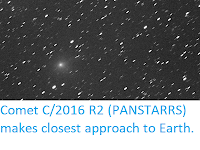Comet C/2017 T3 (ATLAS) will make its closest approach to the Earth
on Wednesday 1 August 2018 reaching a distance of 1.35 AU from
the
Earth
(1.35 times as far from us as the Sun, or 202 152 000 km). At this
distance the comet will not be naked eye visible, having a magnitude of
11.40, which means it would require a good telescope to observe it, and
then preferably in the Southern Hemisphere, as it is currently
in the
constellation of Puppis, which cannot be seen clearly from too far north of the
Equator.
Image of C/2017 T3 (Atlas) taken on 23 October 2017 using the remotely operated iTelescope 21 Deep Space Telescope at the New Mexico Skies Observatory in Mayhill, New Mexico. Image
is a composite made of six 60 second exposure. The asteroid is
indicated by the arrow. iTelescope/Marian Urbanic/Fotografický občasník.
C/2017 T3 (ATLAS) was discovered on 14 October 2017 by the Asteroid Terrestrial-impact Last Alert System (ATLAS) search program.
The name C/2017 T3 (ATLAS) implies that it is a non-periodic comet
(C/) (all comets are, strictly speaking, periodic since they all orbit
the Sun, but those with periods longer than 200 years are considered to
be non-periodic), that it was the third comet (comet 3) discovered in
the first half of October 2017 (period 2017 T) and that it was
discovered by the ATLAS program.
The orbit and current position of Comet C/2017 T3 (ATLAS). The Sky Live 3D Solar System Simulator.
C/2017 T3 (ATLAS) has an estimated orbital period of 51 600 years and a
highly eccentric
orbit tilted at an angle of 88.1° to the plain of the Solar System, that
brings it to 0.82 AU from the Sun at perihelion (82% of the distance
between the Earth and the Sun, considerably outside the orbit of Mars);
to 2771 AU from the Sun at aphelion (2771 times as far from the Sun as
the Earth or 92 times as far from the Sun as the planet Neptune,
reaching the innermost part of the Oort Cloud.
See also...
Follow Sciency Thoughts on Facebook.








